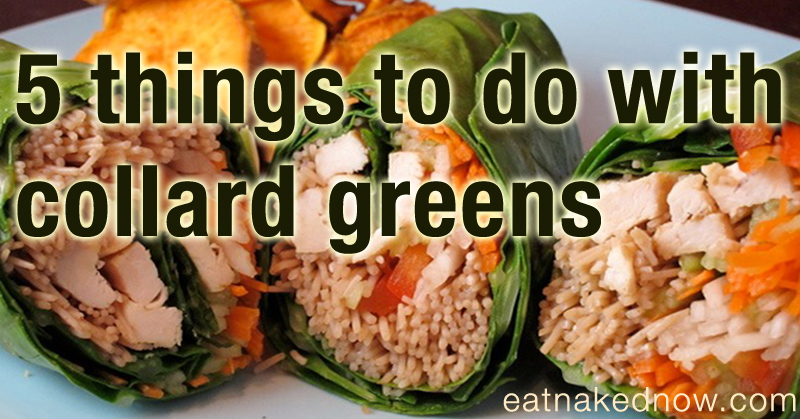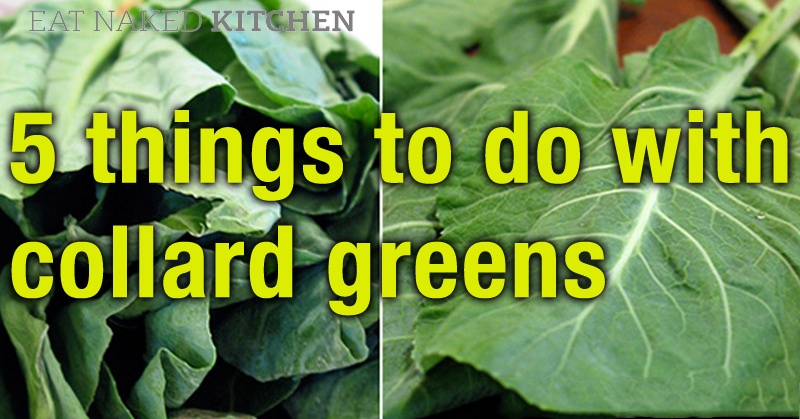Are you in a spinach rut? Looking to expand your horizon of dark leafy greens? Let me introduce you to one of my favorites: the collard green.
Collard greens are nutrient-packed, rich in anti-oxidants, vitamins A, C and K, as well as folate and calcium. Unlike spinach, chard, and beet greens, collard greens don’t contain high amounts of oxalic acid (that stuff that makes your teeth squeaky when you eat too much spinach), an anti-nutrient that can deplete your body of important minerals. They’ve been shown to lower cholesterol, help prevent cancer, and support detoxification. And of course let’s not forget fiber – they’re full of it.

But what to do with these dark green wonders? They’re a little tougher than spinach or swiss chard, which can be a turn-off if you’re not sure how to use them properly. To get you started using this wonder green, here are five ways I use them often:
- In my morning frittata. A frittata is kind of like a crustless quiche, made with eggs and typically lots of veggies. This week my frittata included a little onion, some grated yellow zucchini, red pepper finely diced, and of course some finely chopped collard greens. Delicious! To make a frittata, saute your favorite veggies in a little extra virgin olive oil, coconut oil, or butter from pastured cows. Whisk some eggs in a bowl and pour over the veggies. You can add in some herbs and spices to flavor it up. Let it cook slowly, without stirring. Pop it in the oven under the broiler for a couple of minutes at the end to cook the top. Voila! A yummy morning pizza.
- As a wrap. Watching the starchy-carbohydrates in your diet but love a nice burrito or wrap? Lightly steam a big collard green leaf and use it instead of the tortilla.
- As a bed for your chosen protein. I like to saute a little garlic and finely sliced onion in olive oil with a pinch of sea salt to bring out the flavors. Add some collard greens sliced into thin strips, and cook until a little wilted (about 3-4 minutes). Use this as a “bed” in a big bowl for some sliced grass-fed beef or broiled wild salmon.
- In a marinara sauce. I like to load up my marinara sauce with veggies, and I always include something that’s dark green. Collard greens, chopped into thin strips, are a great addition. They add some nice bulk, flavor and of course lots of nutritional goodies.
- In a veggie bean soup. Just the other day I made a curried vegetable black bean soup, and added some very thinly sliced collard greens toward the end of the cooking time. Super yummy.
Got some great tips of your own for using collard greens? Share them here! I’d love to try them.
(for detailed nutritional information on the health benefits of collard greens, check out The World’s Healthiest Foods)
Tired of the same old vegetables? Here’s 5 things to do with collard greens.




Planning eggplant Parmesan w/ grass fed- beef for dinner. (fresh basil from the pot on the patio) I think there are some collards in the community garden. Hopefully the deer didn’t eat that too! Thanks for the idea : )
you said collards did not have oxalic acid where did you get this information everything I’ve read say it has, and I’ve been trying to find out the best way to eat my greens to get my calcium needed and everything i’ve read say to cook your greens and throw the juice away when i used to drink it. so which is the best way to eat collards and rest of your greens. You see horse and cows and deer eating there greens and they have strong bones and teeth and here I have osteoporsis and allergys. so which way is best thank you
Joyce – you’ve made a good point. Collard greens do have some oxalic acid, but very minimal compared to the others I’ve listed so it’s not one that’s on the “avoid” list for people who are highly sensitive to it. I like collards steamed with some good fats for absorbing the nutrients. In terms of horse/cows/deer… they’re all herbivores and have entirely different digestive tracts than humans do so I wouldn’t compare yourself to them. In terms of calcium — it’s about a lot more than just calcium. it’s about all the co-factors for absorbing/using it (which would actually make a great post… thank you for the idea!)
Basically lose the grains and replace them with greens. That’s my mantra. Anything grains can do, greens can do. Add a little bulk to soup or casserole; be a wrap for sandwiches. Be the bed for proteins and sauces. Be the accompaniment (or bed) for (soft-cooked) eggs instead of toast or potatoes.
I eat just about anything on salad. Nothing is safe! lol
However, even tho I have a nice recipe for pizza crust that is grainfree, it jist ain’t tha same. Oh well. And I won’t worry about biscuits cuz I don’t eat gluten anyway. Pie crust and biscuits just need wheat 🙂
I like my greens all kinds of ways, as well. Last week the went into the bottom of my bowl of chicken posole! I am enjoying these posts and all the information, Margaret. Thank you. @ Hélene I wil often make the pie without the crust–my sons’ favorite is pumpkin, and even though it was Easter, he wanted pumpkin pie–just made the custard! It was delicious.
I just got a bunch of something. tried it, it was spicy, then looked at the tag and it said Collard Greens. what the heck do I do with them. I would probably just put them in a pan with olive oil, salt and pepper. not sure. any advice?
well… I’d start with the ideas in this post and see how you go from there.